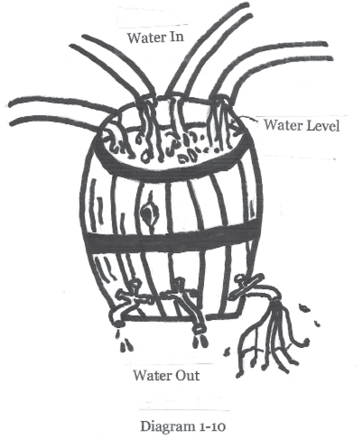An Analogy for an Interconnected Grid
So far, we have a large (networked) interconnection of transmission lines and generators, connected to substations that distribute power to the customers (radially for the most part—the main exception is in big cities). Power is put on the grid by the generators, where it is comingled with all the power generated by all other generators and is then delivered to the substations. A way to understand this is to think of a barrel half full of water with several pipes bringing water to the top of the barrel and with several pipes at the bottom of the barrel taking water out (see diagram 1-10).
As long as the flow of water into the barrel and the flow out of the barrel are equal, the water level in the barrel stays the same. If there is more flow into the barrel than out of the barrel, then the barrel slowly fills up. Conversely, if more water is draining out than is replaced by the pipes at the top, then the barrel slowly empties. Of course, the pipes supplying water at the top represent generators; the pipes at the bottom of the barrel represent load. The level of the water in the barrel is the analogy for the frequency of the system. Similar to the barrel, if there is more generation-supplied power than the customers’ load demand, then the frequency of the grid actually increases, much like the level of water in the barrel would increase.
